Blessing for Torah Study
Baruch atah Adonai, Eloheinu melech ha-olam, asher kid’shanu b’mitzvotav v’tzivanu la'asok b’divrei Torah.
Blessed are You, Adonai our God, Sovereign of all, who hallows us with mitzvot, charging us to engage with words of Torah.
Beginning with Our Own Torah
1) Imagine or recall a moment when you felt safe under a piece of fabric. You can imagine a blanket, a tent, a shawl, a hat, or something else. What about that object helped you to feel safe?
2) What do you associate with a kippah or a tallit? What does it mean to you? What feelings does it evoke?
–––––––––––––––––––––––––––––––––––––––––––––––––––
Tallit
Questions to consider: What is God specifically commanding the Israelites to make? What function might it serve?
(לז) וַיֹּ֥אמֶר יהוה אֶל־מֹשֶׁ֥ה לֵּאמֹֽר׃ (לח) דַּבֵּ֞ר אֶל־בְּנֵ֤י יִשְׂרָאֵל֙ וְאָמַרְתָּ֣ אֲלֵהֶ֔ם וְעָשׂ֨וּ לָהֶ֥ם צִיצִ֛ת עַל־כַּנְפֵ֥י בִגְדֵיהֶ֖ם לְדֹרֹתָ֑ם וְנָ֥תְנ֛וּ עַל־צִיצִ֥ת הַכָּנָ֖ף פְּתִ֥יל תְּכֵֽלֶת׃ (לט) וְהָיָ֣ה לָכֶם֮ לְצִיצִת֒ וּרְאִיתֶ֣ם אֹת֗וֹ וּזְכַרְתֶּם֙ אֶת־כׇּל־מִצְוֺ֣ת יהוה וַעֲשִׂיתֶ֖ם אֹתָ֑ם וְלֹֽא־תָת֜וּרוּ אַחֲרֵ֤י לְבַבְכֶם֙ וְאַחֲרֵ֣י עֵֽינֵיכֶ֔ם אֲשֶׁר־אַתֶּ֥ם זֹנִ֖ים אַחֲרֵיהֶֽם׃ (מ) לְמַ֣עַן תִּזְכְּר֔וּ וַעֲשִׂיתֶ֖ם אֶת־כׇּל־מִצְוֺתָ֑י וִהְיִיתֶ֥ם קְדֹשִׁ֖ים לֵאלֹֽהֵיכֶֽם׃ (מא) אֲנִ֞י יהוה אֱלֹֽהֵיכֶ֗ם אֲשֶׁ֨ר הוֹצֵ֤אתִי אֶתְכֶם֙ מֵאֶ֣רֶץ מִצְרַ֔יִם לִהְי֥וֹת לָכֶ֖ם לֵאלֹהִ֑ים אֲנִ֖י יהוה אֱלֹהֵיכֶֽם׃ {פ}
(37) YHVH said to Moses as follows: (38) Speak to the Israelite people and instruct them to make for themselves fringes on the corners of their garments throughout the ages; let them attach a cord of blue to the fringe at each corner. (39) That shall be your fringe; look at it and recall all the commandments of YHVH and observe them, so that you do not follow your heart and eyes in your lustful urge. (40) Thus you shall be reminded to observe all My commandments and to be holy to your God. (41) I YHVH am your God, who brought you out of the land of Egypt to be your God: I, your God YHVH.
What is a tallit?
Questions to consider: How is a tallit distinct from the tzitzit (tassels) that are on it? Is the tallit itself sacred? How do gender dynamics influence the meaning of a tallit?
"Tallit." Encyclopaedia Judaica, ed. Michael Berenbaum and Fred Skolnik, 2nd ed., vol. 19, Macmillan Reference USA, 2007, pp. 465-466.
TALLIT (Heb. טַלִּית, pl. tallitot; Yid. tales, pl. talesim), prayer shawl. Originally the word meant "gown" or "cloak." This was a rectangular mantle that looked like a blanket and was worn by men in ancient times. At the four corners of the tallit tassels were attached in fulfillment of the biblical commandment of *ẓiẓit (Num. 15:38–41). The tallit was usually made either of wool or of linen (Men. 39b) and probably resembled the abbayah ("blanket") still worn by Bedouin for protection against the weather. The tallit made of finer quality was similar to the Roman pallium and was worn mostly by the wealthy and by distinguished rabbis and scholars (BB 98a). The length of the mantle was to be a handbreadth shorter than that of the garment under it (BB 57b). After the exile of the Jews from Ereẓ Israel and their dispersion, they came to adopt the fashions of their gentile neighbors more readily. The tallit was discarded as a daily habit and it became a religious garment for prayer; hence its later meaning of prayer shawl.
The tallit is usually white and made either of wool, cotton, or silk, although *Maimonides and *Alfasi objected to the use of the latter. Strictly observant Jews prefer tallitot made of coarse half-bleached lamb's wool. In remembrance of the blue thread of the ẓiẓit (see *tekhelet ), most tallitot have several blue stripes woven into the white material (see Zohar, Num. 227a). Until a few decades ago, however, they only had black stripes.
Frequently the upper part of the tallit around the neck and on the shoulders has a special piece of cloth sewn with silver threads (called atarah, "diadem"), to mark the upper (i.e., the "collar") and the outer parts of the four-cornered prayer shawl. Some tallitot have the benediction, recited when putting on the tallit, woven into the atarah.
Rabbi Dr. Marty Lockshin, "What Do Tzitzit Represent?," Women and Tzitzit: Are Some Israelites More Equal than Others? TheTorah.com.
The Talmud records that the opinion of the majority of rabbis was that women were obligated to wear tzitzit to the same extent that men were. The Talmud relates that one second-century sage, Rabbi Judah, used to “attach blue-dyed (fringes) to the aprons of the women of his household.” Only one second-century rabbi, Rabbi Shimon, was listed as exempting women from the commandment of tzitzit.
Forbidding Women to Wearing Tzitzit
Medieval rabbis generally adopted Rabbi Shimon’s position. Most ruled, though, that women were allowed to wear a garment with tzitzit if they wished. Some medieval authorities ruled that women who wore tzitzit could recite the blessing (praising God אשר קדשנו במצותיו וציונו להתעטף בציצית–who sanctified us with His commandments and commanded us to wrap ourselves in tzitzit). Others disagreed. By late medieval and early modern times many rabbis actively opposed women wearing tzitzit.
דיני חוטי הציצית. ובו טו סעיפים:החוטין צריך שיהיו טווין לשמן: (הגה ויש מחמירין אפי' לנפצן לשמן והמנהג להקל בנפוץ) (מרדכי ואגודה סי' כ"ג) שיאמר בתחלת הטווי שהוא עושה כן לשם ציצית או שיאמר לאשה טווי לי ציצית לטלית ואם לא היו טווין לשמן פסולים:
The [fringe] strings have to be spun for their purpose.Rem"a: Some authorities are stringent to even comb them for their purpose. And the custom is to be lenient regarding combing. (Mordechai; Agudah, Section 23)[The spinner] should say at the start of the spinning that he is doing it for the purpose of fringes. Or he should say to a woman [who doing the spinning] "spin me fringes for a shawl." And if the strings were not spun for their purpose, they are unfit.
משֶׁה רַבֵּנוּ עַצְמוֹ רָאָהוּ עַל הַיָּם כְּגִבּוֹר עוֹשֶׂה מִלְחָמָה. וּבְסִינַי כִּשְׁלִיחַ צִבּוּר עָטוּף.
Moses, our teacher, himself envisioned Him at the [Red] Sea as a mighty man, waging war, and, at Mount Sinai, [saw Him] as the leader of a congregation, wrapped [in a tallit].
"Prayer shawl (tallit)," Germany, 1700s-1800s. The Israel Museum, Jerusalem. Silk damask, appliqué panels: ribbed brocaded silk, metal thread braid and purl embroidery.
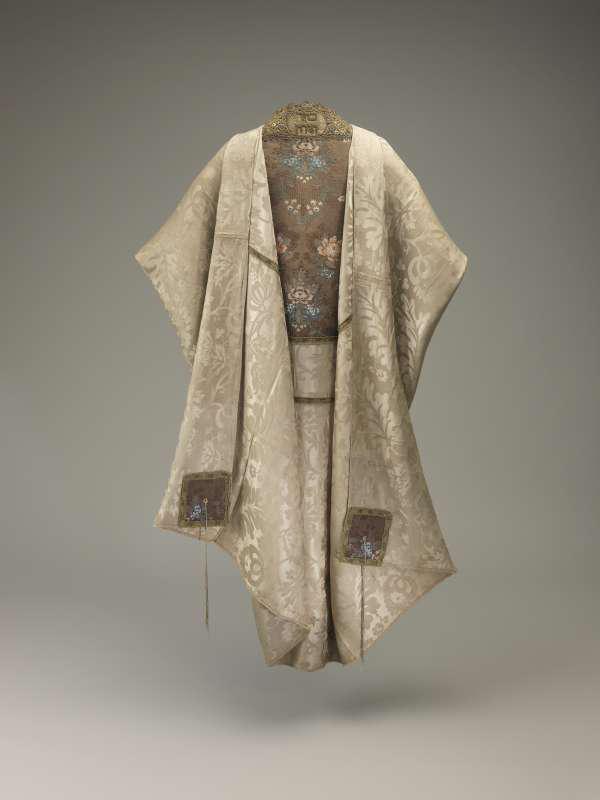
"Tallit, Tzitzit, Tefillin, and Mezuzah: Page from a book of Jewish customs in Germany," by Johann Christof G. Bodenschatz, Frankfurt and Leipzig, 1748–49. The Israel Museum, Jerusalem. Print and copperplate etching on paper.
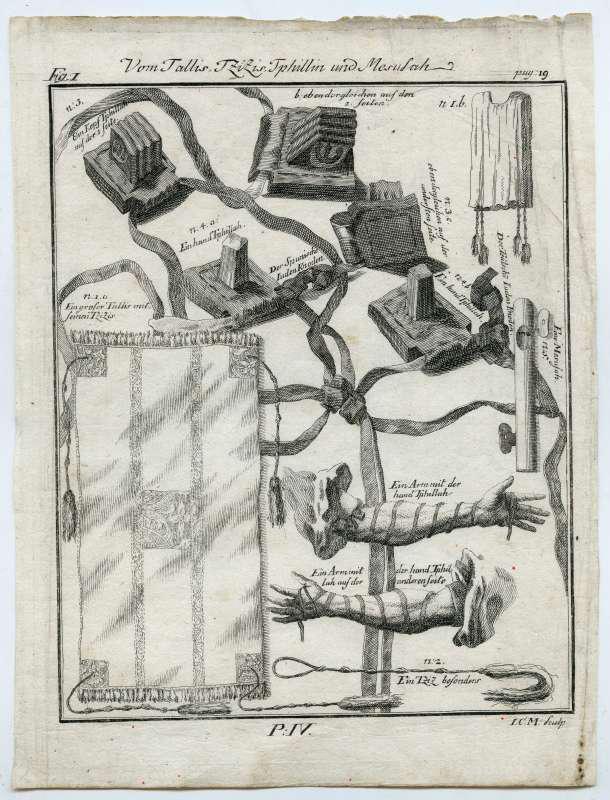
"Prayer shawl (tallit)," Tripoli, Libya, Late 1800s–Early 1900s,
The Israel Museum, Jerusalem. Silk, metal thread.

"Prayer shawl (tallit)," Tafilalet, Morocco, Early 1900s. The Israel Museum, Jerusalem. Cotton, silk-thread embroidery.
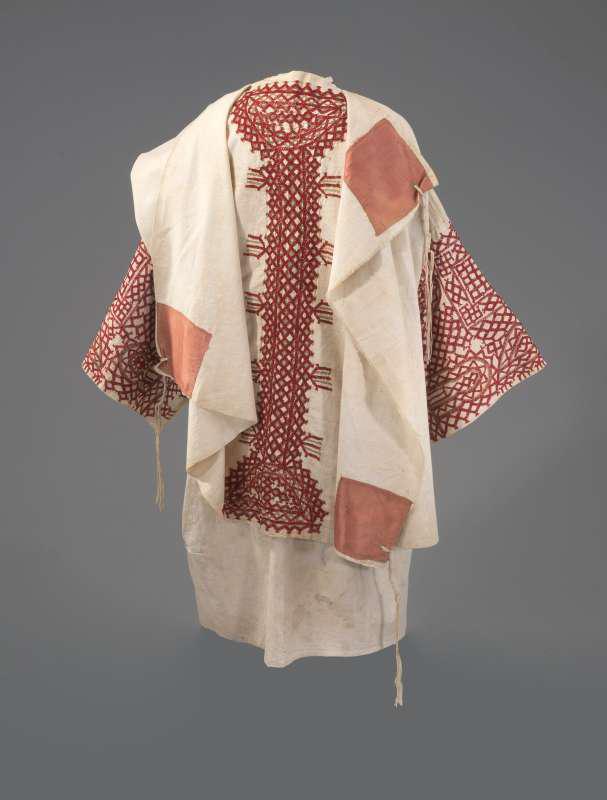
"The Steerage," by Alfred Stieglitz, 1907. The Jewish Museum photogravure.
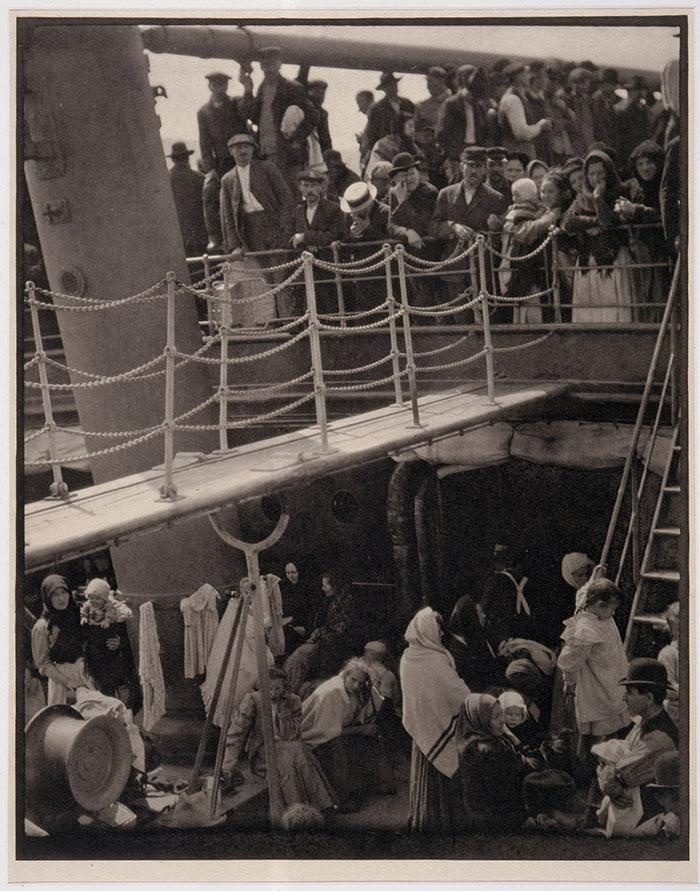
–––––––––––––––––––––––––––––––––––––––––––––––––––
Kippah
Questions to consider: What is the purpose of a kippah? In what way is a kippah like a tallit?
וּמִדְּרַב נַחְמָן בַּר יִצְחָק נָמֵי אֵין מַזָּל לְיִשְׂרָאֵל. דְּאִימֵּיהּ דְּרַב נַחְמָן בַּר יִצְחָק אָמְרִי לַהּ כַּלְדָּאֵי: בְּרִיךְ גַּנָּבָא הָוֵה. לָא שְׁבַקְתֵּיהּ גַּלּוֹיֵי רֵישֵׁיהּ. אֲמַרָה לֵיהּ: כַּסִּי רֵישָׁיךָ, כִּי הֵיכִי דְּתִיהְוֵי עֲלָךְ אֵימְתָא דִשְׁמַיָּא, וּבְעִי רַחֲמֵי. לָא הֲוָה יָדַע אַמַּאי קָאָמְרָה לֵיהּ. יוֹמָא חַד יָתֵיב קָא גָרֵיס תּוּתֵי דִיקְלָא, נְפַל גְּלִימָא מֵעִילָּוֵי רֵישֵׁיהּ, דְּלִי עֵינֵיהּ חֲזָא לְדִיקְלָא, אַלְּמֵיהּ יִצְרֵיהּ, סְלֵיק, פַּסְקֵיהּ לְקִיבּוּרָא בְּשִׁינֵּיהּ.
And from that which transpired to Rav Naḥman bar Yitzḥak as well it can be derived that there is no constellation for the Jewish people, As Chaldean astrologers told Rav Naḥman bar Yitzḥak’s mother: Your son will be a thief. She did not allow him to uncover his head. She said to her son: Cover your head so that the fear of Heaven will be upon you, and pray for Divine mercy. He did not know why she said this to him. One day he was sitting and studying beneath a palm tree that did not belong to him, and the cloak fell off of his head. He lifted his eyes and saw the palm tree. He was overcome by impulse and he climbed up and detached a bunch of dates with his teeth. Apparently, he had an inborn inclination to steal, but was able to overcome that inclination with proper education and prayer.
אָמַר רַבִּי יְהוֹשֻׁעַ בֶּן לֵוִי: אָסוּר לְאָדָם שֶׁיְּהַלֵּךְ אַרְבַּע אַמּוֹת בְּקוֹמָה זְקוּפָה, שֶׁנֶּאֱמַר: ״מְלֹא כׇל הָאָרֶץ כְּבוֹדוֹ״. רַב הוּנָא בְּרֵיהּ דְּרַב יְהוֹשֻׁעַ לָא מְסַגֵּי אַרְבַּע אַמּוֹת בְּגִילּוּי הָרֹאשׁ. אָמַר: שְׁכִינָה לְמַעְלָה מֵרָאשֵׁי.
Rav Huna, son of Rav Yehoshua, would not walk four cubits with an uncovered head. He said: The Divine Presence is above my head, and I must act respectfully.
"The Origin of the Jewish Hat," by Chen Malul, National Library of Israel Blog, 2014.
One of the earliest illustrations of such a hat perched atop the head of a Jew is found in the early 14th-century Codex Manesse. In the image, we see the figure of Süsskind von Trimberg, a Jewish poet and troubadour, wearing just such a hat.
Interestingly, the pointed hat was not always identified with Jews. This style could be found in various places in medieval Europe and was worn by aristocrats and high-ranking officials, among others. Before the 12th century, even English peasants would wear the hat in imitation of the upper classes. How then, did this popular hat eventually come to be associated uniquely with Jews?
At the height of its fashion, at the turn of the 12th century, the pointed hat suddenly fell out of favor, around the time of the tragic and violent encounter between West and East during the First Crusade. Before making their way to Constantinople and the Holy Land, some crusaders led pogroms against German Jewish communities. These fueled anti-Jewish sentiment and imagery, which featured negative depictions of Jews wearing the pointed hat. Thus the item began to be associated in the medieval European mindset with the “killers of Christ” and with treachery in general. What self-respecting Christian would want to wear such a hat after that?
Jews’ lives and dress changed dramatically following the decisions of the Fourth Lateran Council in 1215, which decreed that Jews living in Christian lands must dress in a manner that distinguished them from the Christian population....
As was often the case throughout history, rather than object, the Jewish communal leaders chose to view the decree as a positive commandment. Thus, various rabbis, from Menachem Hameiri (1249–1310) in Spain to Yosef Karo (1488–1575), author of the Shulhan Arukh, in Safed, ruled that a believing Jew may only utter the name of the Lord or pray when his head is covered. Some, like Rabbi Yaakov ben Rabbeinu Asher (1270–1340), recommended that Jews not leave their homes with their head uncovered. Thus, one can view the modern yarmulke or kippah as the direct descendant of the attempt to transform the “Jewish hat” into something to be proud of – an integral part of their religious life.
"Codex Manesse: Süsskind, the Jew of Trimberg," Zurich, Between 1300-1340, Bibliotheca Palatina of Heidelberg.
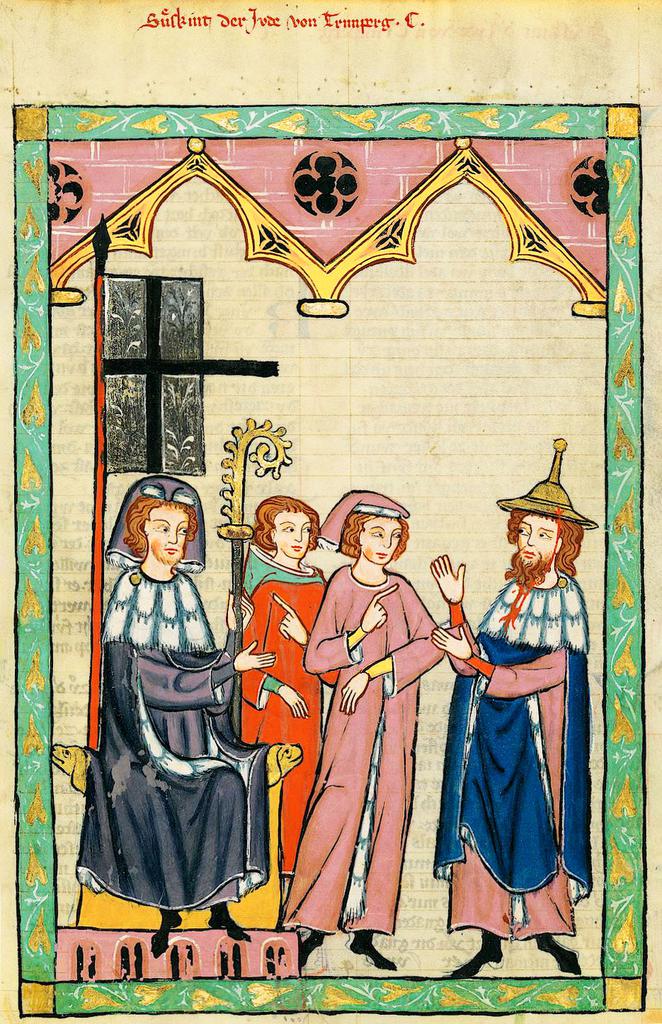
"Festive skullcap (yarmulke)," Poland, 1700s, The Israel Museum, Jerusalem. Linen, shpanyer-work, remains of gilt metal tinsel and purl couched raised embroidery, decorated with gold leaf and sequins.
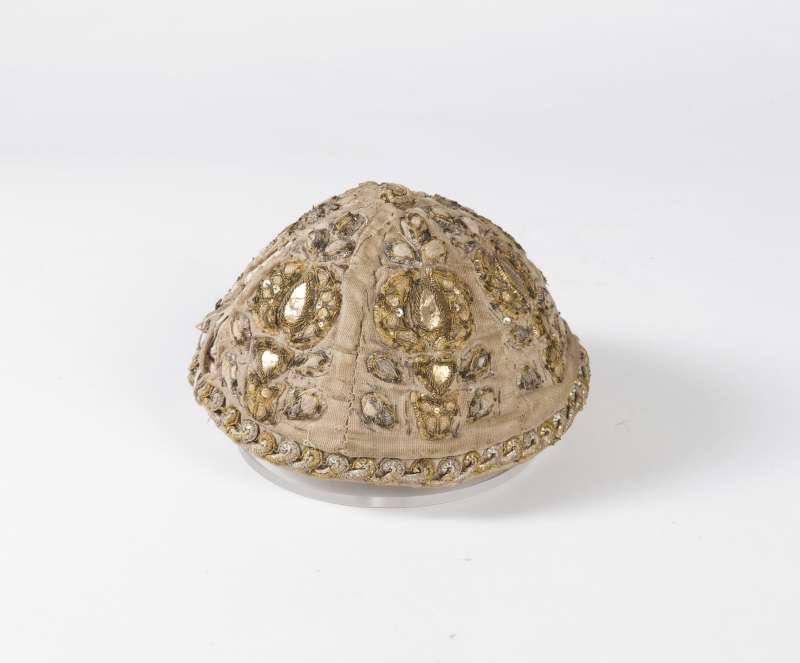
"Cap," Uzbekistan, Late 1800s – Early 1900s. The Jewish Museum. Silk brocade with metallic thread; cotton crocheted; cotton base.
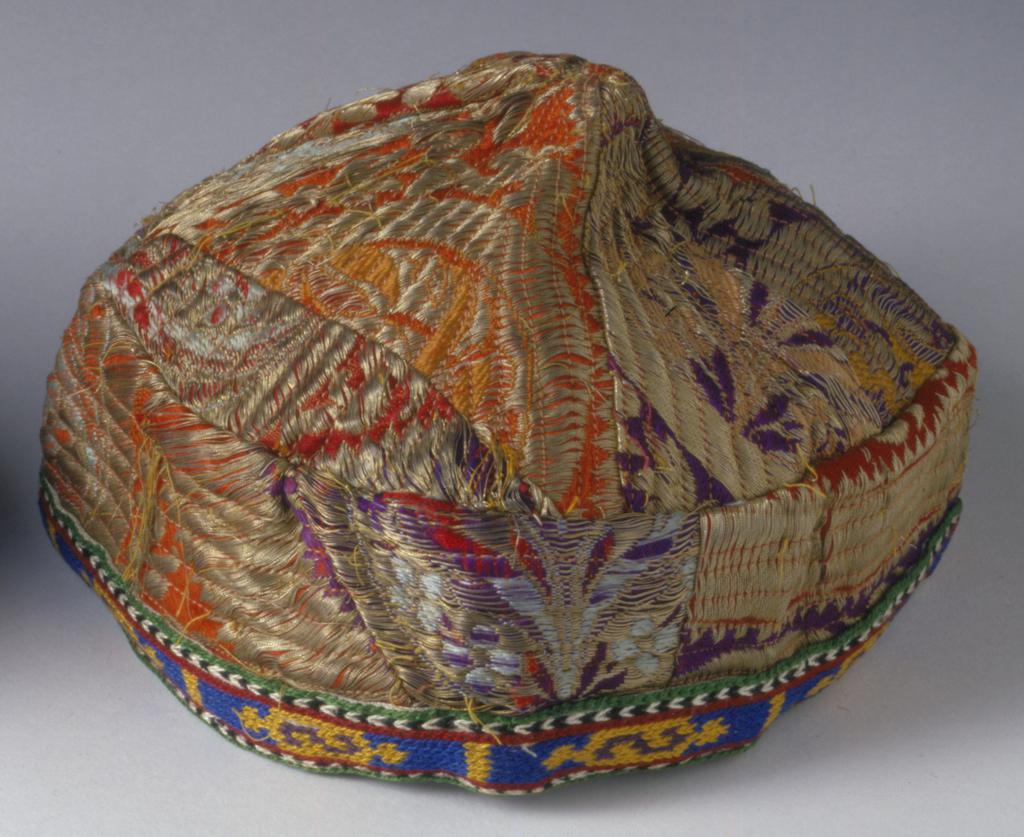
"Jewish Hats in Different Times," Yefet in Jaffa, Early 1900s. National Library of Israel. Yiddish Ad.
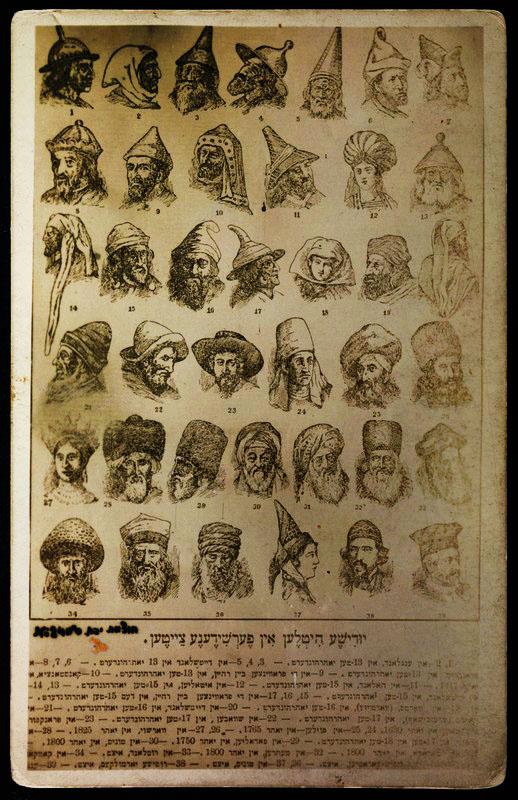
More information:
"Dress," by Yeivin, Ze'ev, et al. Encyclopaedia Judaica, ed. by Michael Berenbaum and Fred Skolnik, 2nd ed., vol. 6, Macmillan Reference USA, 2007, pp. 12-17.



